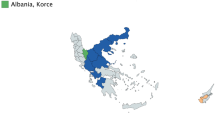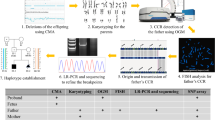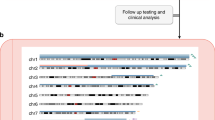Abstract
As there is some evidence that individuals bearing supernumerary marker chromosomes (SMCs) might have an increased risk of being uniparentally disomic for the structurally normal homologues of the SMC, we made a systematic search for uniparental disomy of the autosomal homologues from which SMCs were derived. Of the 22 families studied, a biparental origin of the normal homologues was demonstrated in 21, and 1 case of paternal isodisomy of chromosome 6 was detected in the carrier of a supernumerary marker ring chromosome 6 which itself was of maternal origin. Our results confirm that uniparental disomy may be found in association with SMCs, but until more cases are studied we can only speculate on their frequency and the mechanism(s) which result in this phenomenon.
Similar content being viewed by others
Introduction
Supernumerary marker chromosomes (SMCs) are detected in <0.1% of the general population, but in 0.327% of the mentally retarded [1]. Ramos et al. [2] and Buckton et al. [1] have suggested that the presence of a SMC at meiosis may interfere with normal chromosome disjunction resulting in aneuploidy, and it has been shown that an increased incidence of aneuploidy is associated with an increased risk of uniparental disomy (UPD) by mechanisms of aneuploidy correction [3, 4].
The first hypothesis suggesting a link between a SMC and UPD was that of Robinson et al. [5], who proposed that, in some individuals with a small inv dup(15) SMC and Prader-Willi syndrome (PWS), the disease phenotype may be the result of maternal uniparental disomy of the two normal homologues of chromosome 15. The first evidence that a SMC may be ascertained in combination with UPD was reported by Robinson et al. [6] who described 2 individuals with small inv dup(15) chromosomes; one had paternal isodisomy for chromosome 15 and Angelman syndrome. The other had maternal UPD and PWS.
The prediction of phenotypic risks associated with the ascertainment of an SMC is highly problematic and, with the exception of chromosome 15 markers [7, 8], correlations between the chromosomal origin of markers and their associated phenotypes have not convincingly emerged [9–11]. This karyotype/phenotype correlation would be further complicated if the presence of a SMC predisposes the patient to an increased risk of a concomitant UPD for the normal homologues, as it has been shown that developmental and growth defects may be associated with UPD.
As the frequency of UPD in association with SMCs is unknown, we have carried out a systematic study to determine the parental origin of the normal homologues of the chromosomes from which the SMCs are derived. The SMCs originating from chromosome 15 are reported elsewhere [8], and in this communication we present our results on 22 patients with a SMC which is not of chromosome 15 origin.
Materials and Methods
Study Population
Details of the study population are found in table 1. The chromosomal origin of the SMCs was defined by fluorescence in situ hybridisation in 39 families where the mother, father and proband were available, and of these, 22 have an autosomal origin other than chromosome 15. Peripheral blood was obtained from the proband and both parents in these 22 families and used for the extraction of DNA, the establishment of permanent lymphoblastoid cell lines at the European Collection of Animal Cell Cultures (ECACC), and for conventional cytogenetic and molecular cytogenetic studies. In cases where it was impossible to differentiate between markers of 13 or 21 origin, or between 5 or 19 origin, the parental origin of the normal homologues of both autosomes was determined. The seventeen probands with SMCs of chromosome 15 origin from part of a separate study [8].
Methods
The chromosomal origin of the SMCs was determined using non-isotopic in situ methods as described by Crolla et al. [10]. DNA was extracted from whole blood by a salt precipitation technique [12]. The parental origin of the normal homologues of the chromosomes from which the SMCs originated was determined by polymerase chain reaction (PCR) amplification of chromosome-specific microsatellite repeat sequences [13]. Primers were chosen that amplified sequences located distal to the regions represented by the SMCs, and PCR conditions were those described by Hudson et al. [14]. Details of the primers have been previously published and can be obtained from the Genome Data Base or on request from the authors. PCR products were visualised using a 6% denaturing Polyacrylamide gel followed by autoradiography. Since the object of the study was to determine the frequency of UPD of whole chromosomes as opposed to chromosome regions, a single result indicating a biparental origin of the normal homologues was considered sufficient to exclude UPD.
Results
The results are shown in table 1 from which it can be seen that the normal homologues are biparental in origin in all the probands except case 5 which showed paternal uniparental isodisomy for chromosome 6 in association with a SMC(6) of maternal origin. The proband is a female with intrauterine growth retardation who developed transient neonatal diabetes and details of this case have been reported elsewhere [15].
Discussion
Uniparental disomy is recognised as a possible outcome of a number of mechanisms for aneuploidy correction including gamete complementation, monosomy duplication and trisomy correction [4]. In searching for examples of UPD in humans, efforts so far have been concentrated on those populations who, because of their abnormal chromosome constitutions, were thought to be at increased risk of non-disjunction involving specific chromosomes, and by definition at increased risk of producing UPD by aneuploidy correction [16]. In this context, it has been suggested that the presence of a SMC may interfere with normal disjunction during meiosis, resulting in aneuploidy [1]. Two cases of UPD in association with SMCs have been reported [6]: one was uniparental isodisomy and the other heterodisomy. In this study we have identified a case of paternal uniparental isodisomy in association with a SMC. There are a number of different mechanisms which could result in UPD in carriers of SMCs and some of the possibilities are shown in figure 1.
Possible mechanisms for UPD in association with a SMC. (1) A = Premeiotic marker formation followed by meiosis; B = fusion of gamete bearing SMC with normal gamete; C = duplication of normal homologue rescues partial monosomy. (2) A = Fusion of normal gametes results in disomic zygote; B = postzygotic homologue breakage and marker formation; C = partial monosomy corrected by duplication of remaining normal homologue. (3) A = Fusion of normal gametes results in disomic zygote; B = postzygotic duplication of one homologue results in trisomie zygote; C = trisomy corrected by loss of extra homologue with concomitant SMC formation results in (a) uniparental isodisomy + SMC or (b) biparental normal homologues + SMC. (4) A = Nondisjunction at meiosis; B = fusion of disomic gamete with normal gamete; C = trisomy corrected with breakage of homologue resulting in (a) uniparental heterodisomy of normal homologues + SMC or (b) biparental normal homologues + SMC. (5) A = Premeiotic/familial marker formation and nondisjunction at meiosis; B = fusion of disomic gamete (+ SMC) with normal gamete; C = random loss of one of the normal homologues results in (a) uniparental heterodisomy of normal homologues + SMC of same parental origin or (b) biparental normal homologues + SMC.
Postzygotic events resulting in marker formation or UPD might be associated with mosaicism for the SMC and/or UPD, in which case it is possible that the normal homologues may be biparental in a normal diploid line. In our case, the SMC was present in 80% of lymphocytes and although we have not formally ascertained the parental origin of the chromosomes 6 in those cells without the SMC, these techniques would be expected to detect biparental alleles present in 20% of cells.
Prior to this study, a systematic search for the frequency of UPD in association with SMCs had not been carried out. In 17 cases of SMCs of chromosome 15 origin, UPD for the normal homologues of chromosome 15 was excluded in all 10 cases where parental DNA was available [8]. We have shown that UPD of the normal homologues of the chromosome from which the SMC originated does occur, and there is therefore a case for determining the parental origin of the normal homologues in individuals where a SMC is detected prenatally.
References
Buckton KE, Spowart G, Newton MS, Evans HJ: Forty four probands with an additional ‘marker’ chromosome. Hum Genet 1985;69:353–370.
Ramos C, Rivera L, Benitez J, Tejedor E, Sanchez-Cascos A: Recurrence of Down syndrome associated with microchromosome. Hum Genet 1979;49:7–10
Engel E: A new genetic concept: Uniparental disomy and its potential effect, isodisomy. Am J Med Genet 1980;6:137–143
Engel E: Uniparental disomy revisited — The first twelve years. Am J Med Genet 1993;6:670–674
Robinson WP, Binkert F, Gine R, Vazquez C, Muller W, Rosenkranz W, Schinzel A: Clinical and molecular analysis of five inv dup(15) patients. Eur J Hum Genet 1993;1:37–50.
Robinson WP, Wagstaff J, Bernasconi F, Baccichetti C, Artifoni L, Franzoni E, Suslak L, Shih LY, Aviv H, Schinzel A: Uniparental disomy explains the occurrence of the Angelman or Prader-Willi syndrome in patients with an additional small inv dup(15) chromosome. J Med Genet 1993;30:756–760
Leana-Cox J, Jenkins L, Palmer CG, Plattner R, Sheppard L, Flejter WL, Zackowski J, Tsien F, Schwartz S: Molecular cytogenetic analysis of inv dup(15) chromosomes using probes specific for the Prader-Willi/Angelman syndrome region: Clinical implications. Am J Hum Genet 1994;54:748–756
Crolla JA, Harvey JF, Sitch FL, Dennis NR: Supernumerary marker 15 chromosomes: A clinical, molecular and FISH approach to diagnosis and prognosis. Hum Genet, in press.
Callen DF, Eyre H, Yip MY, Freemantle J, Haan EA: Molecular cytogenetic and clinical studies of 42 patients with marker chromosomes. Am J Med Genet 1992;43:709–715
Crolla JA, Dennis NR, Jacobs PA: A non-isotopic in situ hybridisation study of the chromosomal origin of 15 supernumerary marker chromosomes in man. J Med Genet 1992;29:699–703
Plattner R, Heerema NA, Howard-Peebles PN, Miles JH, Soukup S, Palmer CG: Clinical findings in patients with marker chromosomes identified by fluorescence in situ hybridization. Hum Genet 1993;91:589–598
Miller SA, Dykes DD, Polesky HF: A simple salting out procedure for extracting DNA from human nucleated cells. Nucleic Acids Res 1988;16:1215.
Weber JL, May PE: Abundant class of human DNA polymorphisms which can be typed using the polymerase chain reaction. Am J Hum Genet 1989;44:388–396
Hudson TJ, Engelstein M, Lee MK, Ho EC, Rubenfield MJ, Adams CP, Housman DE, Dracopoli NC: Isolation and chromosomal assignment of 100 highly informative human simple sequence repeat polymorphisms. Genomics 1992;13:622–629
Temple IK, James RS, Shields JPH, Crolla JA, Sitch FL, Betts P, Howell WM, Baum JD, Jacobs PA: Transient neonatal diabetes mellitus and paternal uniparental disomy of chromosome 6: Evidence of an imprinted gene for diabetes on chromosome 6. Nat Genet, in press.
James RS, Temple IK, Patch C, Thompson EM, Hassold T, Jacobs PA: A systematic search for uniparental disomy in carriers of chromosome translocations. Eur J Hum Genet 1994;54:482–488
Fisher AM, Barber JCK, Crolla JA, James RS, Lestas AN, Jennings I, Dennis NR: Mosaic tetrasomy 8p: Molecular cytogenetic confirmation and measurement of glutathione reductase and tissue plasminogen activator levels. Am J Med Genet 1993;47:100–105
Acknowledgements
RSJ is supported by a grant from the Wellcome Trust, and JAC by a grant from Action Research. We are grateful to our colleagues in the Wessex Regional Genetics Laboratory, notably Professor Patricia Jacobs for her encouragement and constructive criticism.
Author information
Authors and Affiliations
Rights and permissions
About this article
Cite this article
James, R.S., Temple, I.K., Dennis, N.R. et al. A Search for Uniparental Disomy in Carriers of Supernumerary Marker Chromosomes. Eur J Hum Genet 3, 21–26 (1995). https://doi.org/10.1159/000472270
Received:
Revised:
Accepted:
Issue Date:
DOI: https://doi.org/10.1159/000472270
Key Words
This article is cited by
-
Forty-two supernumerary marker chromosomes (SMCs) in 43 273 prenatal samples: chromosomal distribution, clinical findings, and UPD studies
European Journal of Human Genetics (2005)
-
A novel mechanism for the origin of supernumerary marker chromosomes
Human Genetics (1996)




